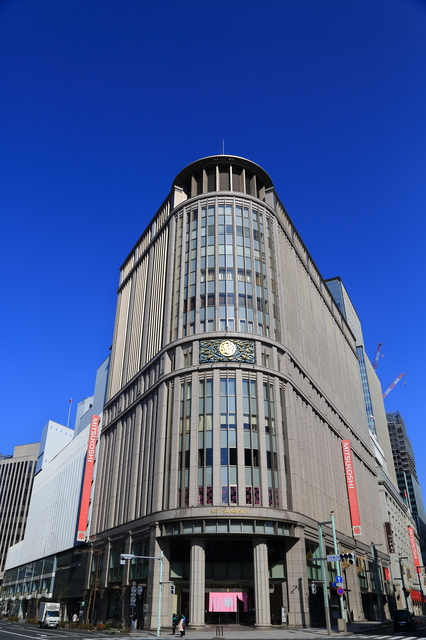“Tokyo Review 020” Nihombashi area-4
Urban Reforming Projects of Tokyo Ward and the birth of department stores
After entering the Meiji period, the “Urban Reforming Projects” which aimed to “promote the permanent public benefit such as business circumstance, sanitation, fire prevention and transportation in the Tokyo city ward” came to be a political challenge, and was not easily realized. It was in the latter half of the Meiji period that some of them had been implemented. Such implementations were widening roads in the city center to create space for trams, improvement of the water supply system, construction of Hibiya Park, and etc.
Another product of this “Urban Reforming Projects” can be found in Nihombashi: “Mitsukoshi” main building where two Lion statues made in England are lying down. Through the reforming project, the west side of the street which we call it “Chuo Dori Avenue” now was expanded by 10m in width and many buildings were forced to evict. In 1914, the Mitsukoshi main building of the Renaissance style with 5 stories has been completed (the name at that time was “New Wing”). Escalators were installed in it as the first case in Japan and it had become a spot for the middle-class people who were longing for a brand new cultural life. The facility to which they had made the “Statement for being a department store”, succeeding the tradition of Echigoya and Mitsui Group, played the role of proposing new life style to citizens.
Meanwhile, “Shirokiya”, which used to be one of the three major garment stores in Edo, opened a new store with three stories, which were a mixed style of Japanese and Western on October 1, 1903. It is said to be the forerunner of comprehensive merchandizing department store as it adopted the selling method of “displaying goods” for the first time and created a “playing corner” with some playground equipment and soba/sushi restaurants. Afterwards, the property was transferred to the Tokyu department store, however it ended up closing in 1999. COREDO Nihombashi (Nihombashi 1-chome Mitsui Building) is currently built on that site.
“Takashimaya” was founded in Kyoto in the late Edo period in 1831 and the Nihombashi Takashimaya as the first store in Tokyo launched in 1933. Adopting the air conditioning / heating system for the entire building. This was the first in Japan, with the largest scale among department stores existing since the early Showa era, and both its interior and exterior appearances are well maintained.
It is designed by an architect named Teitaro Takahashi who won the design competition on the theme “Creating a Modern Taste based on Oriental Preference”. He is also known as a designer of the New Imperial Hotel Main Building. Although it is based on dignified Western European modernism architecture with curved corners, the motif of traditional Japanese architecture can be seen here and there. If you look closely, under the balcony where the flags are raised, you can find a braid that is often found under the eaves in the temple building, besides, “Kaerumata” (Frog’s-legs: a kind of supporting members in wooden buildings) that is also usually seen in temples are adopted at the top of the triple arches as decorations.
The old-fashioned elevators which the guide lady manually operates remains the same since the opening. There are two same style elevators in Nihombashi Mitsukoshi as well, and these are one of the impressive features seen in Nihombashi.
The Takashimaya Nihombashi store had been renovated by Nihombashi 2 Cho-me District Urban Redevelopment Project with the prudent conservation of the main store, and I would like to introduce it later on in this series.
